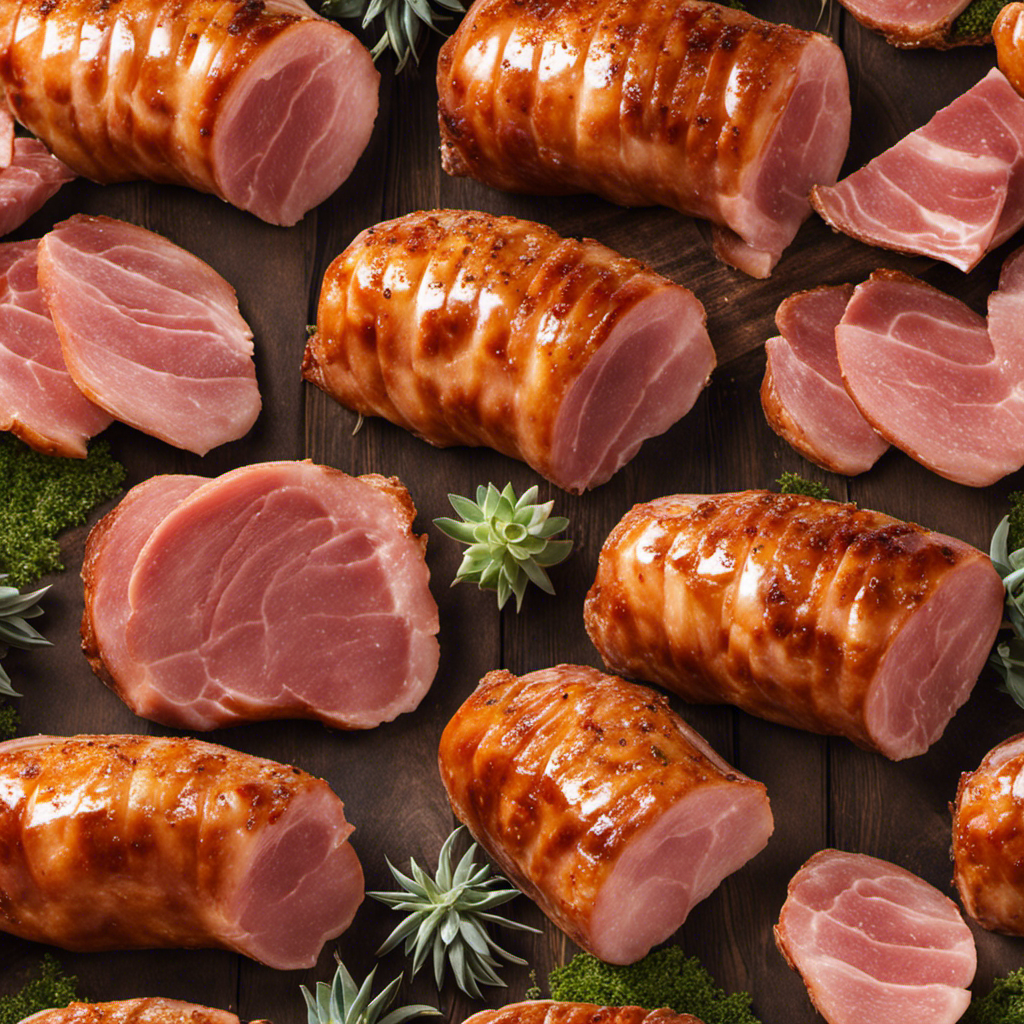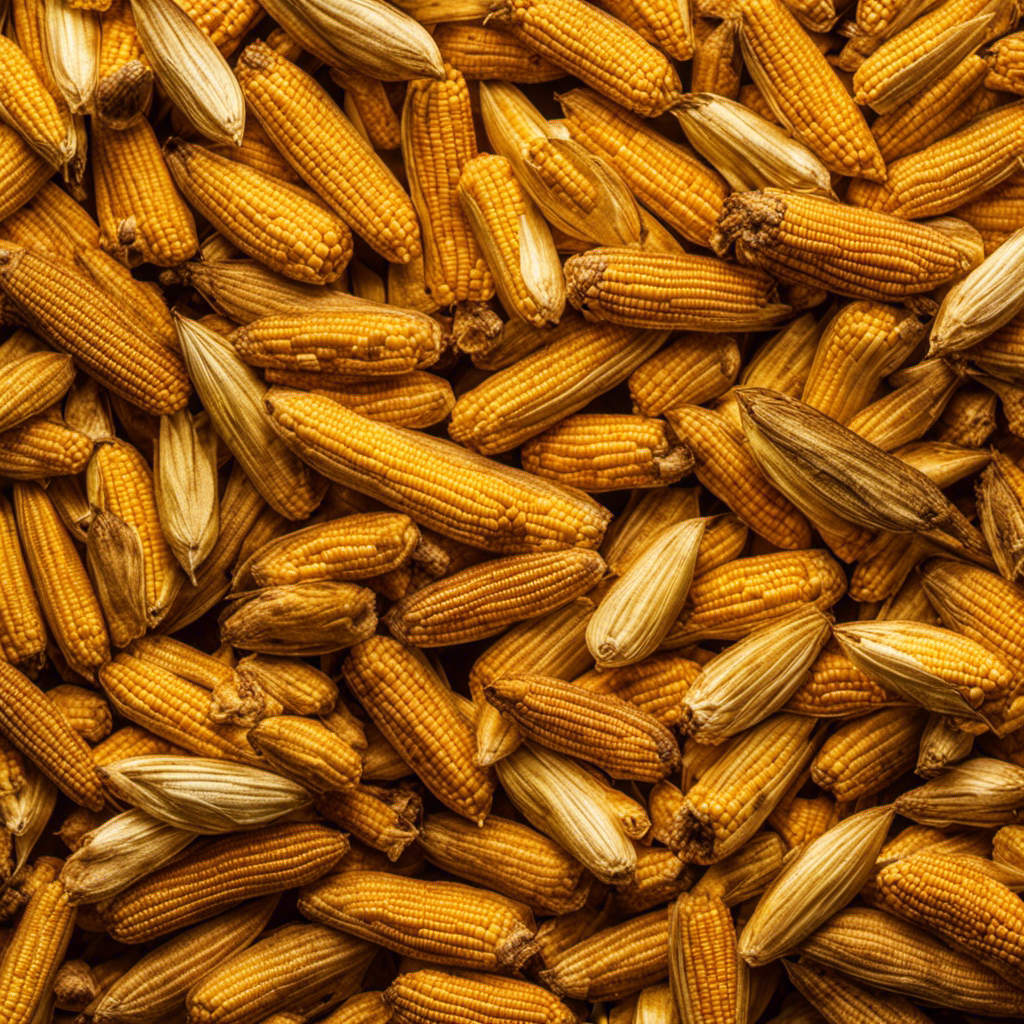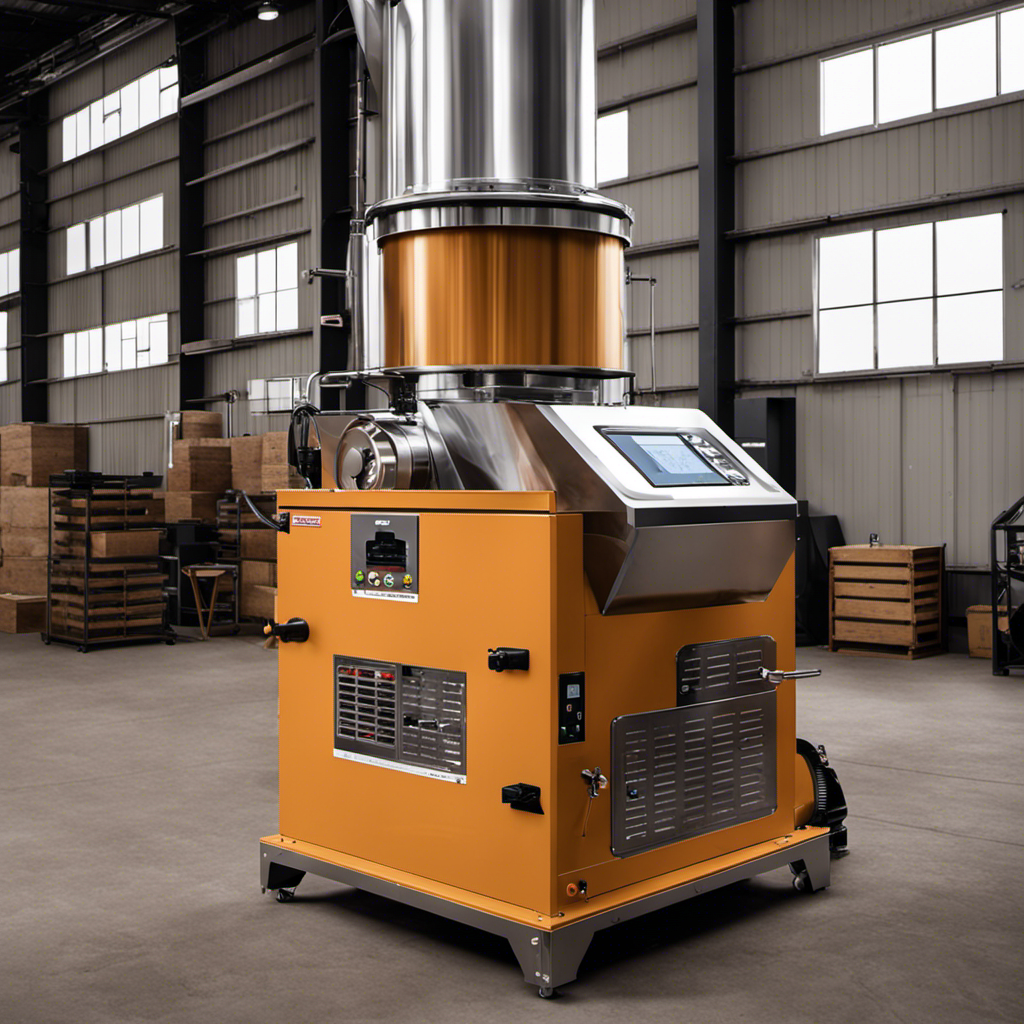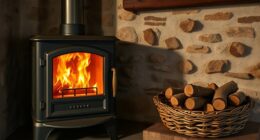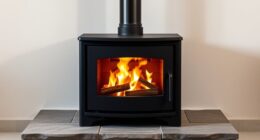I’m here to guide you through the process of preparing a mouth-watering ham by utilizing a wood pellet grill.
Picture this: a tender and juicy ham, perfectly cooked with a smoky flavor that will leave your taste buds dancing.
With my step-by-step guide, you’ll learn all the tips and tricks to make this culinary masterpiece.
From selecting the perfect ham to glazing it for that extra burst of flavor, I’ve got you covered.
So grab your apron and let’s get grilling!
Key Takeaways
- The type of ham (smoked, cured, or fresh) will determine the cooking technique and flavor.
- Proper maintenance and preparation of the wood pellet grill are essential for optimal cooking results.
- Preheating the grill, monitoring temperature, and using a meat thermometer are crucial for cooking the ham to perfection.
- Experimenting with different wood pellet flavors and seasoning techniques can enhance the taste of the ham.
Selecting the Perfect Ham
When selecting the perfect ham, it’s important to consider the size and type of ham you prefer. There are various types of hams available, such as smoked, cured, or fresh hams. Each type requires different cooking techniques to bring out their flavors and textures.
Smoked hams have a rich, smoky flavor and are typically fully cooked, making them easy to prepare. Cured hams are preserved with salt and sugar, resulting in a savory taste that pairs well with glazes. Fresh hams are uncured and have a milder flavor, perfect for those who prefer a less salty taste.
Now that you have selected your ideal ham, let’s move on to preparing the wood pellet grill for cooking.
Preparing the Wood Pellet Grill
Before starting, make sure you’ve prepared the wood pellet grill properly. Wood pellet grill maintenance is crucial for achieving optimal cooking results.
First, clean the grill thoroughly, removing any leftover ashes or food debris.
Next, inspect the grill’s components, such as the fire pot and auger, to ensure they are in good working condition.
Additionally, check the pellet hopper and make sure it is filled with high-quality wood pellets.
To enhance your grilling experience, consider using wood pellet grill accessories like a thermometer to monitor the internal temperature of the grill and a grill cover to protect it from the elements.
With a well-maintained and properly equipped wood pellet grill, you can now move on to seasoning and preparing the ham, infusing it with delicious smoky flavors.
Seasoning and Preparing the Ham
When it comes to grilling ham, the seasoning is crucial in enhancing its flavor. In my experience, the best seasoning for ham includes a combination of brown sugar, mustard, and spices like paprika, garlic powder, and black pepper.
To prepare the ham for grilling, I recommend scoring the surface to allow the flavors to penetrate, and then applying the seasoning mixture generously.
Additionally, there are various seasoning techniques that can be employed, such as marinating the ham overnight or using a dry rub to create a flavorful crust.
Best Seasoning for Ham
The best seasoning for ham on a wood pellet grill is a mix of brown sugar, black pepper, and garlic powder. This combination of flavors adds a sweet and savory profile that perfectly complements the smoky taste of the grill. To achieve the best results, I recommend using the following quantities for a 10-pound ham:
| Seasoning | Quantity |
|---|---|
| Brown sugar | 1/2 cup |
| Black pepper | 1 tablespoon |
| Garlic powder | 1 tablespoon |
To enhance the flavor even further, you can experiment with different smoking techniques and glazes. One popular option is to create a honey glaze by combining honey, Dijon mustard, and a hint of apple cider vinegar. The sweetness of the honey pairs beautifully with the smokiness of the ham. Now that we have the perfect seasoning, let’s move on to preparing the ham for grilling, ensuring a delicious and mouthwatering outcome.
Preparing Ham for Grilling
To prepare your ham for grilling, first, make sure it is fully thawed. Thawing your ham in the refrigerator is the safest method to prevent bacterial growth. Once thawed, you can begin preparing the ham for smoking.
Here are some marinating techniques for ham:
-
Brining: Soak the ham in a mixture of water, salt, sugar, and spices for several hours or overnight. This enhances the flavor and helps to retain moisture during grilling.
-
Dry Rub: Apply a mixture of herbs, spices, sugar, and salt to the surface of the ham. Gently massage the rub into the meat and let it sit for at least an hour before grilling. This adds flavor and creates a delicious crust.
-
Injection: Use a marinade injector to infuse the ham with a flavorful liquid, such as a mixture of fruit juice, spices, and herbs. Inject the marinade evenly throughout the ham for maximum flavor.
-
Overnight Marinade: Coat the ham with a marinade of your choice and let it sit in the refrigerator overnight. This allows the flavors to penetrate the meat and create a delicious smoky taste.
Now that your ham is fully prepared for grilling, it’s time to explore the different seasoning techniques that will take your ham to the next level.
Seasoning Techniques for Ham
Once you’ve prepared your ham for grilling, it’s time to explore different seasoning techniques that will take it to the next level.
Smoking techniques offer a unique and delicious flavor to your ham, and there are several variations to choose from. One popular method is to use a dry rub, consisting of a blend of spices, herbs, and salt. This adds a savory and aromatic crust to the ham as it cooks.
Another option is to brine the ham before smoking, which involves soaking it in a mixture of water, salt, sugar, and other seasonings. This helps to infuse the ham with moisture and flavor.
Additionally, you can experiment with different wood chips or pellets to further enhance the taste.
Now, let’s move on to setting up the wood pellet grill.
Setting up the Wood Pellet Grill
When it comes to setting up a wood pellet grill, there are some important factors to consider in order to achieve optimal results.
First and foremost, temperature control is key, and I’ll be sharing some valuable tips on how to maintain a consistent and precise temperature throughout the cooking process.
Additionally, selecting the right type of pellets is crucial for enhancing the flavor of your food, so I’ll provide some advice on choosing the best pellets for your specific needs.
Lastly, proper maintenance and cleaning of your grill will not only extend its lifespan but also ensure that it continues to perform at its best, and I’ll be covering some essential maintenance and cleaning practices.
Temperature Control Tips
Make sure you’re monitoring the temperature constantly to avoid overcooking or undercooking the ham. Temperature control is crucial when cooking a ham on a wood pellet grill.
Here are some techniques to help you achieve the perfect smoke flavor:
-
Preheat the grill: Start by preheating your wood pellet grill to the desired temperature. This ensures that the ham cooks evenly and absorbs the smoky flavor.
-
Use a meat thermometer: Invest in a reliable meat thermometer to accurately gauge the internal temperature of the ham. This will help you determine when it’s perfectly cooked and safe to eat.
-
Adjust the airflow: Adjusting the airflow on your grill can regulate the temperature and control the level of smoke. More airflow can increase the temperature, while less airflow can lower it.
-
Keep the lid closed: Resist the temptation to constantly check on the ham. Opening the lid can cause temperature fluctuations and affect the cooking time.
By following these temperature control techniques, you’ll be on your way to enjoying a perfectly smoked ham.
Now, let’s move on to some pellet selection advice to enhance the flavor even more.
Pellet Selection Advice
To enhance the flavor even more, you’ll want to choose the right type of pellets for your smoker. The choice of wood pellet brands can greatly impact the taste of your cooked ham. Different wood pellets offer distinct flavors, so it’s important to consider the type of wood that pairs well with pork.
Popular options include hickory, apple, and cherry wood pellets. Hickory provides a strong and smoky flavor, while apple and cherry offer a sweeter and milder taste. The smoking vs grilling techniques also play a role in pellet selection. If you prefer a slow and low smoking method, hardwood pellets are ideal. However, if you want a quicker cook with higher temperatures, fruitwood pellets are a great choice.
Now that you’ve selected the perfect pellets, let’s move on to maintenance and cleaning for your wood pellet grill.
Maintenance and Cleaning
Once you’re finished cooking, it’s important to regularly clean and maintain your smoker to ensure optimal performance. Here are some maintenance tips and cleaning techniques to keep your wood pellet grill in top shape:
-
Empty the ash: After each use, remove the ashes from the firebox. This prevents airflow obstruction and allows for better heat distribution.
-
Brush the grates: Use a grill brush to remove any residue on the cooking grates. This ensures that your ham cooks evenly and prevents any unwanted flavors.
-
Clean the drip tray: Regularly clean the drip tray to prevent grease buildup. This not only improves the taste of your ham but also prevents potential flare-ups.
-
Check the seals: Inspect the gaskets and seals for any signs of wear or damage. Replace them if necessary to maintain proper temperature control.
Having a well-maintained smoker is crucial for cooking the ham low and slow, allowing the flavors to develop and ensuring a tender and juicy result.
Cooking the Ham Low and Slow
For a juicy and flavorful ham, it’s best to cook it low and slow on a wood pellet grill. This cooking technique allows the ham to absorb the smoky flavors from the wood pellets, resulting in a delicious and unique taste. When cooking a ham on a wood pellet grill, you have the option to add additional flavors by using different types of wood pellets. Here are some popular flavor options to consider:
| Wood Pellet | Flavor Profile |
|---|---|
| Apple | Sweet and fruity |
| Hickory | Strong and smoky |
| Maple | Mild and slightly sweet |
Monitoring the Internal Temperature
Once the ham is on the wood pellet grill and cooking low and slow, it’s important to monitor the internal temperature to ensure it reaches the desired doneness. Here’s how to use a meat thermometer for perfect results:
- Insert the meat thermometer into the thickest part of the ham without touching the bone.
- Wait for the temperature to stabilize, usually within a few seconds.
- Check the temperature reading. For a fully cooked ham, the internal temperature should reach 140°F (60°C).
- If you prefer a different level of doneness, adjust the temperature accordingly. For a medium-rare ham, aim for 130°F (54°C), while a medium ham should reach 140°F (60°C).
By monitoring the internal temperature, you can achieve the perfect level of doneness for your ham.
Now, let’s move on to the next step: glazing the ham for extra flavor.
Glazing the Ham for Extra Flavor
After monitoring the internal temperature, it’s time to glaze the ham for extra flavor. Glazing is a crucial step in enhancing the taste and appearance of your cooked ham. There are various glazing techniques you can use to achieve the desired flavors. Popular flavor enhancers include honey, brown sugar, mustard, and fruit juices. Experimenting with different combinations can add a unique touch to your ham. To help you better understand the glazing process, here’s a table outlining some glazing techniques and their flavor profiles:
| Glazing Technique | Flavor Enhancer | Resulting Flavor |
|---|---|---|
| Honey Glaze | Honey | Sweet |
| Maple Glaze | Maple Syrup | Smoky-Sweet |
| Citrus Glaze | Orange Juice | Tangy |
| Dijon Glaze | Dijon Mustard | Spicy |
| Pineapple Glaze | Pineapple Juice | Tropical |
Resting and Serving the Perfectly Cooked Ham
To ensure optimal flavor and tenderness, it’s important to let the cooked ham rest before serving. Resting allows the juices to redistribute within the meat, resulting in a more succulent and flavorful dish.
Here are some resting techniques and serving suggestions to help you achieve the perfect ham:
-
Tent the ham: Place a sheet of aluminum foil loosely over the cooked ham to keep it warm and prevent it from drying out. Let it rest for at least 15 minutes before carving.
-
Carve it right: When ready to serve, carve the ham into thin slices against the grain for maximum tenderness. Use a sharp knife and slice at a slight angle for a more elegant presentation.
-
Serve with accompaniments: Enhance the flavors of the ham by serving it with delicious sides such as glazed carrots, creamy mashed potatoes, or a tangy mustard sauce. These accompaniments complement the ham’s rich and savory taste.
-
Save the leftovers: If you have any leftovers, store them in an airtight container in the refrigerator. The ham can be enjoyed cold or used in various recipes like sandwiches, salads, or casseroles.
Frequently Asked Questions
How Long Should I Let the Ham Rest Before Serving?
I usually let the ham rest for about 10-15 minutes before serving. This allows the juices to redistribute and ensures a moist and tender ham. It’s also a good time to carve the ham properly and add any final glazing touches.
Can I Use Any Type of Wood Pellets for Grilling the Ham?
I can use different flavors of wood pellets for grilling a ham. It’s important to maintain the proper temperature while cooking on a wood pellet grill to ensure the best results.
Can I Use a Gas or Charcoal Grill Instead of a Wood Pellet Grill?
Using a gas or charcoal grill as an alternative to a wood pellet grill has its pros and cons. Gas grills offer convenience and quick heating, while charcoal grills provide a smoky flavor.
How Do I Know if the Ham Is Fully Cooked?
To check if the ham is fully cooked, I use a meat thermometer. Insert it into the thickest part of the ham, avoiding bone. The internal temperature should reach 145°F for safe consumption.
Can I Cook a Frozen Ham on a Wood Pellet Grill?
Sure, cooking a frozen ham on a wood pellet grill is possible. However, it will take longer than a thawed ham. Follow the recommended cooking times and temperature to ensure it’s fully cooked.
Can I Use the Same Method for Cooking a Beef Roast on a Wood Pellet Grill as I Would for a Ham?
Yes, you can use the same method for cooking a beef roast on a wood pellet grill as you would for a ham. The wood pellet grill imparts a delicious smoky flavor to both meats, making it a versatile option for cooking beef roast pellet grill. Just adjust the cooking time accordingly.
Conclusion
In conclusion, cooking a ham on a wood pellet grill is a truly remarkable experience.
As the sweet aroma of the wood pellets fills the air, the ham slowly transforms into a masterpiece of tenderness and flavor.
With each bite, the smoky undertones and perfectly caramelized glaze transport you to a culinary paradise.
The wood pellet grill infuses the ham with a unique smokiness that cannot be replicated by any other cooking method.
So, gather your loved ones, indulge in the mouthwatering delight, and savor the unforgettable taste of a ham cooked to perfection on a wood pellet grill.

